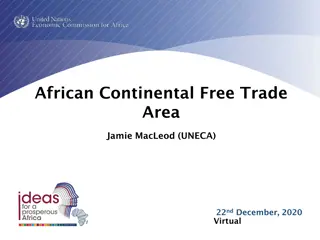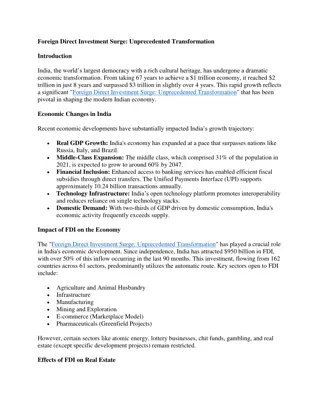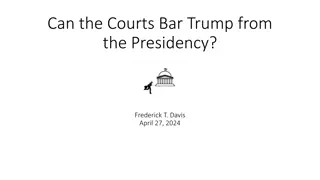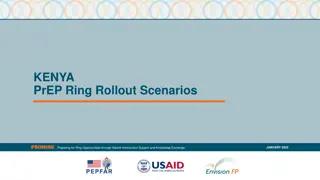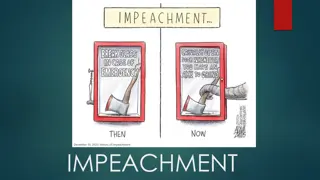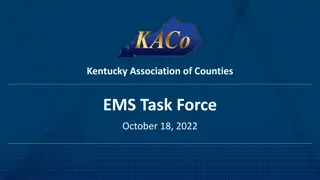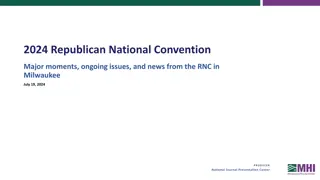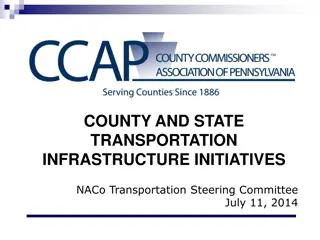President Trump's $1.5 Trillion Infrastructure Plan: Key Points for Counties
President Trump introduced a $1.5 trillion federal infrastructure package with a focus on regulatory reform, aiming to stimulate new investment, shorten project approval times, and address rural infrastructure needs. The plan includes $200 billion in new federal spending, leveraging funds for projects across the U.S. Counties, which own a significant portion of the nation's infrastructure, stand to benefit from increased federal support. Key initiatives involve incentives, rural infrastructure, transformative programs, and regulatory streamlining.
Download Presentation

Please find below an Image/Link to download the presentation.
The content on the website is provided AS IS for your information and personal use only. It may not be sold, licensed, or shared on other websites without obtaining consent from the author. Download presentation by click this link. If you encounter any issues during the download, it is possible that the publisher has removed the file from their server.
E N D
Presentation Transcript
National Association of County Engineers The Voice of County Road Officials Transportation & Infrastructure Legislative Update Alabama County Engineers Association Kevan Stone Executive Director National Association of County Engineers
NACE 2020 ORANGE BEACH (BALDWIN COUNTY), ALABAMA
President Trump Releases Legislative Outline for Infrastructure Plan Highlights for Counties On February 12, 2018, the Trump Administration introduced long-awaited expanded principles outlining a vision for a new 10-year, $1.5 trillion federal infrastructure package. These principles, titled Legislative Outline for Rebuilding Infrastructure in America, expand upon the Infrastructure Initiative white paper that accompanied President Trump s FY 2018 budget back in February of 2017. The administration has stated that this document is open to revisions by Congress as they look to craft legislation based off the administration s principles. In the proposal, President Trump states: To help build a better future for all Americans, I ask the Congress to act soon on an infrastructure bill that will: stimulate at least $1.5 trillion in new investment over the next 10 years, shorten the process for approving projects to 2 years or less, address unmet rural infrastructure needs, empower State and local authorities, and train the American workforce of the future. As counties own 46 percent of the nation s roads, 38 percent of the nation s bridges and are involved in over one-third of the nation s airports and transit systems, increased attention from the White House is a welcome development. Counties invest over $122 billion each year in construction, maintenance and rehabilitation of the nation s infrastructure network, but cannot address the substantial project backlog without a strong partnership with and assistance from the federal government. The White House s infrastructure plan is comprised mainly of several new initiatives, modifications to existing programs and regulatory reform.Overall, the plan calls for $200 billion in new federal spending, with the goal of leveraging those dollars to yield a total of $1.5 trillion in new spending and financing for infrastructure projects across the country. New spending under the plan would be broken down according to the chart below: Program New Funding Provided Percentage of New Funding Incentives Program $100 Billion 50 percent Rural Infrastructure $50 Billion 25 percent Transformative Programs $20 Billion 10 percent Expansion of Existing Loan Programs $20 Billion 10 percent Federal Capital Financing Fund $10 Billion 5 percent
The Plan Focuses Heavily on Regulatory Streamlining and Reform and Transfers Additional Regulatory Responsibility to States In addition to the funding and financing components, the president s infrastructure plan focuses on regulatory reform. This is important to counties as regulatory hurdles and bureaucratic red-tape can increase project costs exponentially while causing major delays in project completion. Some of these reforms will originate at the federal level and some will be delegated to States. The administration plans to introduce a one agency, one decision environmental review structure under which a lead federal agency would assume authority to greenlight permitting processes: The president s plan calls for this to occur working collaboratively not sequentially with all other pertinent agencies to reach one decision before signing off. The plan calls for this process to take no longer than 21 months, with actual permits issued within 3 months after. This would equal the two-year maximum time for permit processes, reflecting a goal of the administration to shrink that timeline from what can sometimes be ten and even 20 years long. The plan will require a single environmental review document and a single record of decision (ROD) coordinated by the lead agency: This would result in having one ROD for each project, rather than having numerous ROD s on any given project. Additionally, National Environmental Policy Act (NEPA) reviews would not need to be completed before undertaking certain tasks, such as the installation of certain small cells and wi-fi infrastructure. Rail right-of-way executions would also be permitted before relevant NEPA reviews are conducted under the plan. The plan calls reduced duplication and increased flexibility in establishing and using categorical exclusions (CE): These exclusions are important to counties as they allow for quicker completion of projects by having certain NEPA requirements waived for smaller scale projects. NACE championed CE provisions in both MAP-21 and FAST Act reauthorization bills for federal surface transportation projects. The plan directs the Council on Economic Quality (CEQ) to issue new regulations designed to streamline the NEPA process: NACo has met with CEQ numerous times over the past year, recognizing the footprint the White House would have in environmental streamlining. This plan solidifies CEQ as a leading agency tasked with crafting the administration s regulatory plan. The plan seeks to streamline regulations for highways: Most notably, the plan states its desire to authorize utility relocation to take place prior to NEPA review completion. Other assistance is provided by reclassifying the threshold for large projects to $1 billion, allowing for smaller projects to navigate the regulatory landscape more quickly.
To Raise or not to Raise, that is the Question Trump on the gas tax: President Donald Trump told Bloomberg in early 2017 that he "would certainly consider" raising the gas tax, noting that truckers trade association is in favor of it. For Chairman of the National Economic Council Gary Cohn floated the idea of a 7- cent increase in the gas tax in a meeting with House Republicans in late 2017. In a 2018 Meeting with then House Transportation Chairman Bill Shuster, President Trump floated a 50 cent increase in the gas tax. House T&I Chairman Peter DeFazio has proposed a 25 cent increase phased in over a 5-year period. Senate Finance Leaders have gone on record saying there will be no increase in the federal gas tax.
Where We Stand Today. U.S. House of Representatives Democrat: 235 Republican: 199
Where we Stand Today. United States Senate Republican: 53 Democrat: 45 Independent: 2 (Both I s caucus with Democrats)
Infrastructure Bill? President Trump, House Democrats, and Senate Republicans have all expressed interest in an infrastructure bill. Senate Minority Leader Schumer has stated that climate change must be addressed in any potential infrastructure bill this Congress. Speaker Pelosi echoed those statements. Chairman DeFazio says any bill out of his committee will include provisions on climate resiliency and action to reduce emissions. Ranking Member Graves says that if pieces of the controversial (Green New Deal) resolution slip into the infrastructure bill, "that could be a deal- killer." The White House and Congressional Leaders have agreed that a package should have a target of $2 trillion. The follow-up meeting disintegrated as President Trump declared his unwillingness to work with Congressional Democrats as long as they continue to investigate him. Additionally, President Trump suggested a new NAFTA agreement pass Congress before addressing infrastructure.
Reauthorization Bill Aside from a possible infrastructure bill, the current surface transportation bill (Highway Bill) expires in 2021. This year, the House and Senate will begin hearings on what should be revised, reformed and added. This is time to educate your state s members of Congress and Senators on your priorities.
Americas Transportation Infrastructure Act (ATIA) On Tuesday, July 30, the U.S. Senate Environment and Public Works Committee unanimously approved a five-year surface transportation reauthorization measure spanning FY 2021 through 2025. The America s Transportation Infrastructure Act (ATIA) (S. 2302) authorizes $287 billion in funding from the Highway Trust Fund for the nation s highway surface transportation programs over five years, representing a roughly 27 percent increase over the levels authorized in the previous legislation, the Fixing America s Surface Transportation (FAST) Act of 2015, which is set to expire in September 2020.
Americas Transportation Infrastructure Act (ATIA) Maintains the off-system bridge set-aside: ATIA maintains the set-aside under the Surface Transportation Block Grant Program (STBGP) that mandates no less than 15 percent of a state s STBGP allocation be directed to the repair and rehabilitation of bridges off the federal-aid highways system. This set-aside is critical as it increases the amount and flexibility of STBGP dollars allocated to counties for the improvement of off-system bridges. Counties own and maintain 64 percent of the nation s 281,184 off-system bridges. Streamlines the federal permitting process: The bill codifies certain tenants of the One Federal Decision Executive Order, establishing a two-year goal for completion of environmental reviews; a 90-day timeline for related project authorization; a single environmental document and record of decision to be signed by all participating agencies; and an accountability and tracking system to be managed by the U.S. Secretary of Transportation.
Americas Transportation Infrastructure Act (ATIA) NEW competitive grants for bridges: The legislation authorizes more than $6 billion over five years, including $3.3 billion from the Highway Trust Fund, for a new competitive bridge grant program to address the growing backlog of bridges in poor conditions nationwide. Under this competitive program, states and counties may apply directly for funding through the U.S. Department of Transportation (DOT). Counties own and operate 38 percent of the National Bridge Inventory, over 50 percent of which are considered structurally deficient and in need of repair.
Americas Transportation Infrastructure Act (ATIA) NEW funding and focus for resilient infrastructure: ATIA emphasizes resiliency throughout the bill and expands the eligibility for resilient infrastructure projects to receive federal funding. Resilient measures counties could fund through the bill include relocating roadways to a higher elevation, stabilizing slopes, replacing culverts with bridges or upsizing culverts, tide gates and improving natural features. In addition, the legislation directs specific funding for highway infrastructure that could be affected by flooding, drought, wildfires, rockslides, levee and dam failures and earthquakes. This is particularly important for counties, as 788 counties or 26 percent faced at least one major disaster declaration in 2018. The bill also provides significant federal investments for communities to build long- lasting, resilient transportation infrastructure by creating the Promoting Resilient Operations for Transformative, Efficient and Cost-saving Transportation (PROTECT) grant program. The PROTECT program would provide $3.9 billion in formula grants and $1 billion in competitive grants, respectively, over five years and would assist areas in recovering from and/or preparing for natural disasters by directing funds to develop resilient infrastructure in vulnerable communities. The PROTECT Program has two components:
Americas Transportation Infrastructure Act (ATIA) NEW formula grant program: Funded at $786 million per year via the Highway Trust Fund, the formula grant portion of PROTECT will be distributed to states in the same share the state receives based on its core formula apportionments. These funds may be used for construction activities that improve the resiliency of assets to current and future weather events and natural disasters, for strategies that allow for a continuity of operations or rapid recovery of surface transportation systems that serve critical needs following a disaster, including evacuation routes, or to protect coastal infrastructure that is at long-term risk to sea level rise. The federal share is 80 percent; however, funding from other federal sources may be used to cover the remaining 20 percent. NEW competitive grant program: Funded at $200 million per year from the Highway Trust Fund, this portion of the grant program is intended to enable communities to assess vulnerabilities and plan infrastructure improvements and emergency response strategies to address community needs. Local governments may apply directly to U.S. DOT for funding in this portion of the PROTECT program.
America's Transportation Infrastructure Act NEW programs for transportation safety projects: The legislation increases and expands safety provisions, including designating leading pedestrian intervals as an eligible project and allowing states the flexibility to use Highway Safety Improvement Plan (HSIP) funds for educational campaigns on traffic safety and enforcement activities. ATIA creates several new safety grant programs: NEW formula safety incentive grant program: ATIA establishes a formula safety incentive program for states funded at $500 million per year from the Highway Trust Fund. Upon receival of the funds, a state must then sub- allocate 65 percent of their share based on population. This incentive program would mandate states use half the funding for highway safety improvement projects, while the remaining half can be used for any project that is eligible under STGBP so long as the state can prove progress is being made to address its vulnerable road safety assessment. If performance data demonstrates a state is making progress in this area, the federal share is equal to 100 percent. NEW competitive traffic fatality reduction grant program: ATIA also establishes a fatality reduction program funded at $100 million annually from the Highway Trust Fund. Eligibility is directed toward state and local governments where data shows an adversely high number of fatalities or serious injuries resulting from traffic accidents have occurred. Successful applicants will be states and other units of government who can demonstrate progress in reducing these averages. The grant criteria, which may be funded at up to a 100 percent federal share, is based on the ability of a state or local government to demonstrate one or more of the following: Reducing per capita serious injuries and fatalities Reducing rates of serious injuries and fatalities per vehicles miles traveled (VMT) Having the lowest per capita serious injuries and fatalities Having among the lowest per-VMT serious injury and fatality averages Innovative safety efforts
Americas Transportation Infrastructure Act Increases sub-allocation amounts for Transportation Alternatives Program (TAP) Projects: The bill increases the TAP set-aside within the STBGP, as well as its sub-allocation amounts, while also providing smaller communities greater access. TAP was created under the FAST Act and provides funding to projects considered alternative to traditional highway construction. Counties utilize the TAP program for pedestrian and bicycle facilities, trails, safe routes to school projects, community improvements and environmental mitigation, among others. NEW language added to give counties the opportunity to receive 100 percent of TAP set-aside funds allocated to states: The legislation includes new language mandating states disperse funds they receive through the TAP set-aside with an opportunity to allocate up to 100 percent of the funds referred to counties and other local transportation entities. This provision will give counties the opportunity to receive more federal funding for specific infrastructure projects.
Americas Transportation Infrastructure Act Increases funding for the Nationally Significant Freight and Highway Projects Program Increases investments in tribal and federal lands transportation programs NEW environmental provisions to reduce motor vehicle carbon emissions and road congestion
Now What? It is important to remember this is only the first step in what will be a long bipartisan and bicameral process. Here's what needs to happen: Senate Passes Bill out of Committee 1. 2. Full Senate Votes in Favor of Bill (60 votes) 3. House Pass Bill out of Committee 4. Full House Votes in favor of Bill (Majority vote needed) 5. Chambers go to Conference (A conference Committee is members from both chambers selected (by leadership) to work together to form one Bill from the House and Senate versions.) 6. Conferees (members of Conference Committee) must sign off on the one bill that will then go to both chambers for a vote. 7. Both Chambers must pass the Conference Committee Bill (Conference Report). 8. President Signs Legislation, thus becoming law.
Facebook Twitter - @EngineersNACE
THANK YOU! Kevan Stone Executive Director National Association of County Engineers kstone@naco.org







